| Title | Image | Summary of text |
|---|---|---|
| Goeree - Natural Design - Page 351 |  | The text discusses the depiction of intense emotions in art, noting that painters often capture dramatic passions. It mentions a story about Duke Gonzaga and an Italian painter training another artist in evoking real emotions. The passage highlights the challenge of portraying true emotions naturally in paintings. |
| Goeree - Natural Design - Page 352 |  | This passage discusses the depiction of human figures avoiding something dreadful, highlighting how different parts of the body should move in harmony with each other. It also explains how an expression of wonder can be represented through the careful arrangement of hands and head posture. Furthermore, it advises that in running actions, the limbs should not be arranged similarly to maintain the expression's natural feel. |
| Goeree - Natural Design - Page 353 |  | The text discusses the mechanics of walking, emphasizing the movement of arms and legs akin to four-legged animals to increase speed. It notes the hindrance caused by carrying objects while walking, which impedes speed and agility. Additionally, it mentions how these principles apply differently to children and static figures. |
| Goeree - Natural Design - Page 354 | 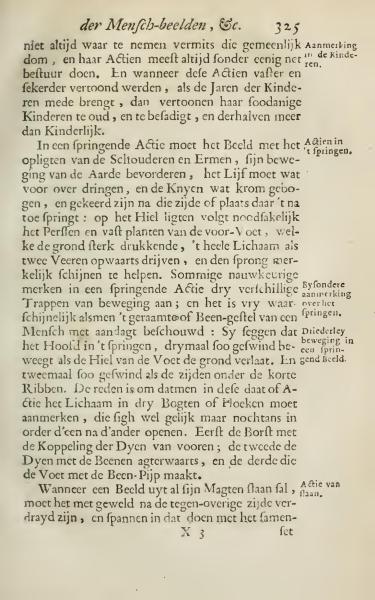 | The text discusses the dynamics of movement, especially jumping, in artistic depictions of human figures. It explains how lifting the shoulders and arms, along with bending the knees, assists in jumping, and describes the three stages of motion in such actions. The observation includes details on the speed and turns of various body parts during motion. |
| Goeree - Natural Design - Page 355 |  | The passage discusses the concept of drawing and depicting physical exertion and emotion through art. It references how an archer's tension is represented by holding breath to convey strength, which can sometimes cause physical strain. Additionally, it touches on the expression of internal emotions like anger through facial expressions, using Cain from biblical lore as an example. |
| Goeree - Natural Design - Page 356 |  | The text discusses the depiction of emotions and states of despair through bodily gestures, using a historical examination of posture and expression in art. It describes how a person in despair might be imagined in art, with details on posture, facial expression, and attire. The section ends by comparing genuine sadness to depicted states of despair. |
| Goeree - Natural Design - Page 357 |  | The text describes the depiction of various emotional states through physical gestures. For a desperate person, the text suggests an exaggerated extension of the arms and uncertainty reflected in their posture. It also describes the portrayal of anger through specific facial and bodily expressions, such as grasping the throat, clenched fists, and fierce expressions. |
| Goeree - Natural Design - Page 358 |  | This text discusses different human expressions and actions, such as wrath, jealousy, and repentance, and how they can be depicted or faked in art. It provides details on the physical gestures and postures that convey these emotions. Additionally, it touches on the artificial nature of some actions, comparing them to theatrical performances where expressions lack true origin. |
| Goeree - Natural Design - Page 359 |  | The text discusses how actors strive to give natural performances to please their audience. It highlights the importance of imagination, teaching, and the movement of the mouth and lips in portraying actions that appear lifelike. The text also offers insights into exercises using points on a plane to enhance the appearance of movements in performances, emphasizing the beauty and usefulness of such practice. |
| Goeree - Natural Design - Page 360 |  | The text discusses the relationship between clothing and human figure representation in art. It argues that both clothed and nude figures are essential in painting and sculpture, expressing the full potential and understanding of the artist. The author criticizes those who think clothing representation is trivial, comparing inadequate figures to children's dolls. |
| Goeree - Natural Design - Page 361 |  | The text discusses the importance of intelligently arranging clothing folds in artistic representations of figures. Properly understanding and applying these techniques prevents unnatural and incorrect draping. The text also emphasizes the inherent nature of materials, encouraging a natural return to flatness while ensuring the fold's origin remains expressive and visible. |
| Goeree - Natural Design - Page 362 |  | The text is a heading and a caption in Dutch, describing a study of the draping of clothing. It relates to the illustration showcasing how garments might be depicted on a human figure. The focus is on the origin and arrangement of clothing folds. |
| Goeree - Natural Design - Page 363 |  | The text discusses the importance of accurately depicting folds in art, emphasizing that folds should only appear if there is a legitimate reason. It critiques the tendency of some to misinterpret artistic rules and highlights the need for careful selection of materials to properly convey the appearance and weight of clothing. The passage also advises considering the consistent height in depictions of garments. |
| Goeree - Natural Design - Page 364 |  | This section discusses the importance of observing the folds and tensions in the clothing covering human figures, ensuring they follow the natural lines of the body. Incorrectly displaying these elements can disrupt the overall perception and presentation of the figure. The text also emphasizes understanding the perspective of the folds to accurately portray clothed figures. |
| Goeree - Natural Design - Page 365 |  | The text describes an 'Actual Occupations' scene illustrating the incidental sight point of drapery folds in moving figures. It is likely an instructive caption accompanying the image for teaching purposes in an artistic study context. |
| Goeree - Natural Design - Page 366 |  | The text discusses the depiction of the human form in art, focusing on the perspective and dynamics of clothing and limbs. It considers the relevance of both visible and invisible aspects, like the soul, in artistic representation, arguing for a natural and lively portrayal. There's an emphasis on how the art might align with genuine human studies, potentially altering perceptions of both painted and sculpted forms. |
| Goeree - Natural Design - Page 367 |  | This text discusses the captivating power of painting to create lifelike representations of human figures from inanimate materials. It highlights how these figures appear to perform actions like walking or speaking, creating an illusion of life. The text also emphasizes the importance of understanding both the physical movement and the internal thoughts and passions in art, suggesting that these aspects should be considered in human studies. |
| Goeree - Natural Design - Page 368 |  | This text discusses the concept of the "soul of art" as it relates to the portrayal of human figures. It also examines the idea of "animal spirits" within humans, explaining their role in sustaining life, and compares them to the mechanical operation of a clock. The text provides insights into how these concepts relate to human studies and art. |
| Goeree - Natural Design - Page 369 | 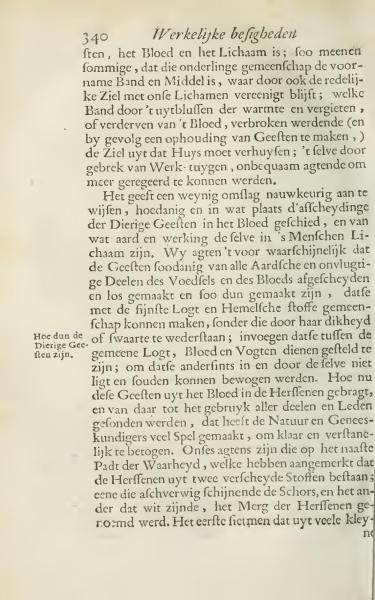 | The text discusses the connection between the body and the rational soul through blood and the body. It explores the separation and function of animal spirits, which are believed to be light and able to interact with the finest substances. The text also examines the composition of the brain as consisting of two distinct materials. |
| Goeree - Natural Design - Page 370 |  | The text discusses the process of moving fine substances through intricately twisted threads similar to distillers' methods. Only the finest components of blood can pass through long folded brain tubes, serving different mental functions. The passage highlights the relationship between the brain structures and the flow of spirits or fluids, comparable to how the heart manages blood. |
| Goeree - Natural Design - Page 371 |  | The text discusses the role of spirits or essences, which move through the body's cavities and are vital in bodily functions due to their free movement. It explains how inhalation affects these spirits, influencing our health and life span, while drawing comparisons to the movement of blood through arteries. The explanation emphasizes the function of nerves as extensions of the brain, contributing to bodily control and life. |
| Goeree - Natural Design - Page 372 | 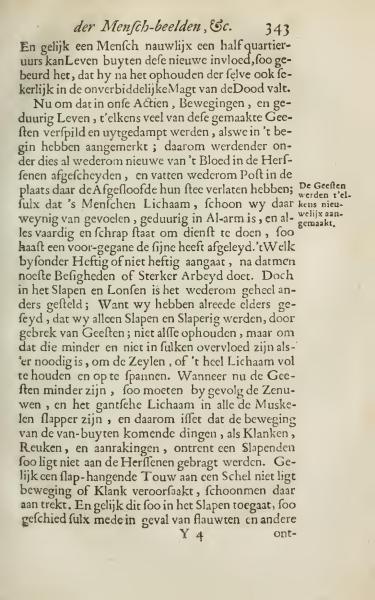 | The text discusses how humans require certain influences to continue living and how these are quickly expended. It explains that new vital forces, or spirits, are continually generated to keep the body in a state of readiness. However, during sleep, these forces are less abundant, which makes the body and nerves more relaxed and less responsive to external stimuli, similar to how a loose rope doesn't easily ring a bell. |
| Goeree - Natural Design - Page 373 |  | The text discusses the phenomenon of sleep, explaining how the body's functions slow down, and new "spirits" rejuvenate the person during rest. It notes that the quality of sleep is influenced by the food consumed and describes how a person's posture affects the ease of falling asleep, with lying down being more beneficial than sitting upright. Finally, it elaborates on the process of waking as these renewed spirits activate the body. |
| Goeree - Natural Design - Page 374 |  | The text describes how a person, whether sitting or standing, can experience a slackening of spirits, leading to nodding off or losing their balance. This physical reaction is linked to the delay or disruption of these internal energies, which are compared metaphorically to spirits travelling through the body's nerves and muscles. The text humorously discusses the potential consequences and remedies such as rocking both children and adults to induce or maintain sleep. |
| Goeree - Natural Design - Page 375 |  | The text discusses how sudden shocks can awaken someone, integrating humor with the serious topic of soothing a crying child. It shares a story of a woman trying to calm her crying child on a ferry, which amuses her fellow passengers. The humor and varied sounds eventually cause the child and its mother to fall asleep. |
| Goeree - Natural Design - Page 376 |  | The excerpt discusses the movement of the body and its relation to the soul, comparing it to water moving in a barrel. It explores the role of spirits in transmitting sensation and the impact of these concepts on understanding human ailments and experiences, such as dizziness and drowsiness. The text emphasizes the rational soul's divine creation and its role in governing the body with wisdom and independence. |
| Goeree - Natural Design - Page 377 |  | The text discusses the concept of distinguishing between Reason and Will, which are identified as the two main faculties of the mind. It emphasizes understanding each faculty within its own nature and operation to easily comprehend complex ideas. The passage also distinguishes between internal and external presentations to the mind, explaining how each type informs our understanding. |
| Goeree - Natural Design - Page 378 | 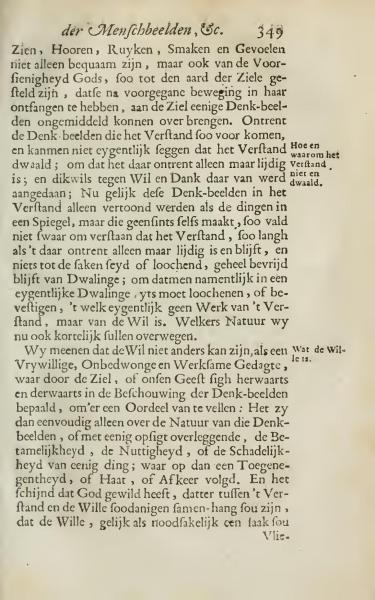 | The text discusses the interplay between sensory perception and the mind, emphasizing that the mind reflects thoughts passively like a mirror without actively engaging in error. Actual error comes from the will, not the understanding. It further explains that the will is an active thought process necessary for making judgments, aligned with divine intention. |
| Goeree - Natural Design - Page 379 |  | This text focuses on the nature of the human will, emphasizing its intrinsic freedom. It argues that the will cannot be compelled even by divine forces, underscoring a philosophical view of its independence. Additionally, it discusses the process of judgment and the importance of pursuing truth through contemplation and mental clarity. |
| Goeree - Natural Design - Page 380 |  | The text discusses the pursuit of wisdom, suggesting that true understanding comes from focusing on pure thoughts without mingling them with other distractions. It emphasizes the importance of reverence for God as the foundation of wisdom and warns against relying solely on the doctrines of others to avoid straying from the truth. The passage suggests that personal reflection and direct understanding of divine principles are keys to true insight. |
| Goeree - Natural Design - Page 381 |  | The text explores the steadfastness of conscience and the roots of understanding, choice, and thinking in human nature. It discusses the idea of conscience as a form of awareness within us, acting as a witness with our spirit. Additionally, it touches on scholarly disputes about conscience, suggesting that mixing conscience with other faculties of the soul results in misunderstanding. |
| Goeree - Natural Design - Page 382 | 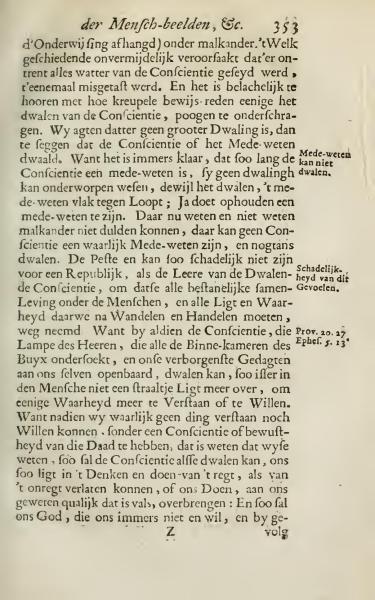 | The text discusses the concept of conscience, emphasizing that conscience, as true knowing, cannot deviate. It warns against the errors and potential harm of deviating conscience, describing it as comparable to a plague for society. The argument is that conscience is essential for understanding truth and moral action, acting as an inner guiding light. |
| Goeree - Natural Design - Page 383 |  | This text discusses how apparent truths can deceive individuals, challenging our assurance and trust in knowledge. The author critiques contemporary philosophers who advocate for universal doubt, arguing that such approaches undermine wisdom, arts, and sciences, as well as moral reformation. The text questions whether we can be certain in our beliefs and actions when our conscience is no longer a reliable guide. |
| Goeree - Natural Design - Page 384 |  | The text discusses the concept of guilt and innocence, particularly in the context of conscience and judgment. It argues that sin affects the faculties of the soul but does not completely remove one's awareness or conscience. It also notes the importance of distinguishing between conscience, will, and judgment in the study of human figures. |
| Goeree - Natural Design - Page 385 |  | The text discusses the nature of conscience, distinguishing between a stained and weak conscience, and how a person can act wrongly while believing they are doing right due to ignorance or misleading education. It also delves into historic debates by anatomists and philosophers about where the soul is located within the human body, with differing views placing it in the heart, stomach, blood, or brain. |
| Goeree - Natural Design - Page 386 |  | The text discusses the philosophical and anatomical views of Descartes on the dual nature of our sensory tools, like eyes and ears, and the central role of the pineal gland in uniting sensory perceptions. It outlines Descartes’ idea that the pineal gland is the primary seat of the soul because it integrates diverse sensory inputs. These concepts are linked to the belief that this gland helps unite the sensory impressions within the brain. |
| Goeree - Natural Design - Page 387 |  | The text discusses how human perception and movement are influenced by the soul and its interaction with the body, particularly the brain and nerves. It suggests that true understanding of movement and perception extends beyond anatomical study of dead bodies. The text critiques the limitation of contemporary medical practices which cannot fully capture the dynamic aspects of life, such as the flow of blood and animating spirits. |
| Goeree - Natural Design - Page 388 |  | The text discusses the belief that if a method to maintain human functionality without disruption were created, many perceptions might change. It reflects on the ideas of trusting one's spirit over external influences. The section by Spinoza argues the unity of body and soul, with thinking being a mode determined by God as the Universe, and discusses the movement of the body determined by external factors. |
| Goeree - Natural Design - Page 389 |  | The text reflects on human limitations in understanding the divine, using the allegory of Icarus. It discusses the relationship between the soul and body, highlighting that full comprehension of bodily functions by laws of nature without involving the soul is unattainable. The text mentions the work of a medical scholar on common sensations and their perception by the soul. |
| Goeree - Natural Design - Page 390 |  | The text discusses the concept of the soul and its interaction with the body, particularly through the senses. It suggests that while the soul is not physically located in the body, it influences and receives reports through the senses, with a focus on the importance of sight. The passage also addresses philosophical ideas about perception and awareness and highlights the critical role of interpreting sensory input correctly. |
| Goeree - Natural Design - Page 391 |  | The text discusses how the rays from the furthest points of objects intersect before entering the eye, akin to a camera obscura setup. It emphasizes the importance of understanding how perceived images are transmitted through the optic nerves to the brain. The explanation includes details on how light forms images accurately and why further study of visual perception is needed. |
| Goeree - Natural Design - Page 392 |  | The text discusses the fundamental elements of eye anatomy and their depiction in artistic sketches. It explains how light rays interact with the optic nerves and the brain's inner surfaces, similar to how light behaves in a camera obscura. The text notes the significance of these concepts for the accurate representation of human figures in artworks. |
| Goeree - Natural Design - Page 393 |  | The page features diagrams related to light and vision, illustrating concepts like reflection, eye anatomy, and perspective. It is part of a work teaching human figure studies for artistic purposes. The images reflect scientific exploration of vision relevant to artists in the 17th century. |
| Goeree - Natural Design - Page 394 |  | This text discusses the perception of objects through the optic nerves and brain, emphasizing how objects are interpretable based on their movement and the brain's response. It explains how movements influence the soul and describes how optic nerve fibers affect the perception of colors, sounds, and flavors. The functioning of nerves related to the ears and tongue is also discussed in relation to hearing and taste. |
| Goeree - Natural Design - Page 395 | 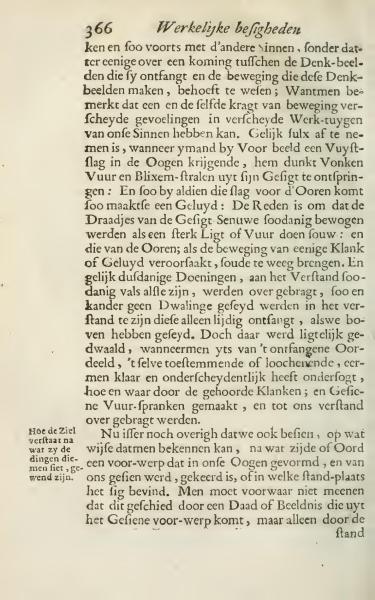 | The text discusses the functioning of the senses and the nature of perception. It explores how mental images and sensory perceptions might not necessarily correspond, using examples such as perceiving sparks of fire when hit. The treatise also touches on how the mind processes these perceptions accurately or inaccurately, highlighting the role of the intellect in discerning truth. |
| Goeree - Natural Design - Page 396 |  | The text discusses how the brain and nerves interact to perceive objects and physical positions. Changes in limb positions influence brain function, allowing the mind to understand object location and direction. It also examines how light affects perception and the perceived size of objects at various distances. |
| Goeree - Natural Design - Page 397 | 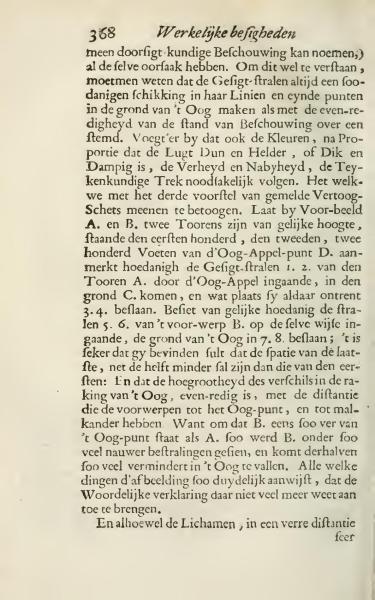 | The text discusses how visual perception works, emphasizing the parallel between the formation of vision rays in the eye and visual observation. It explains how the characteristics of colors, distance, and height must be considered in this visual arrangement. A diagram is used to demonstrate this, comparing the perspective of two towers at different distances from the eye and how this affects perception. |
| Goeree - Natural Design - Page 398 |  | The text discusses how perception and experience influence our understanding of the size and configuration of objects. It explains that while objects might appear smaller or larger due to visual circumstances, they aren't necessarily so. The author compares this to recognizing human forms in art, noting that experience helps us discern proportions correctly, unlike children, who judge differently. It also touches upon optical illusions similar to seeing objects in a mirror. |
| Goeree - Natural Design - Page 399 |  | The text explains how bodies and objects appear in relation to the surfaces of mirrors and water. It describes the perception of distance, posture, and light in reflections and discusses the visibility of objects through rays. An example is given of people viewing the moon's reflection in water, illustrating how individual perspectives differ based on position. |
| Goeree - Natural Design - Page 400 |  | The text explores the perception of countless points formulated by the rays of the Moon, using lenses as a metaphor. It discusses how the Soul and Body are intertwined, yet a material body and an immaterial spirit work together, though the process is beyond full comprehension. The text notes the complexities in understanding how immediate perception and action occur between the Soul and Body. |
COPYRIGHT © 2024 STUDY DRAWING. ALL RIGHTS RESERVED.